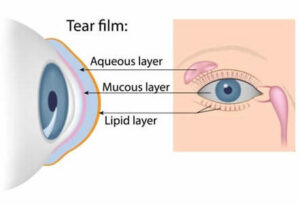Has your vision become blurry? Do you feel like there’s something in your eye, even if there’s nothing there?
These are some of the signs of dry eye syndrome. Dry eye syndrome is a chronic condition that millions suffer from.
Dry eyes can cause uncomfortable symptoms that may come and go. Without proper treatment, dry eyes can become chronic, but it doesn’t mean the symptoms will become permanent.
Keep reading to learn more about dry eye syndrome and how to treat it to avoid it worsening.
What is Dry Eye Syndrome?

Dry eye syndrome is a chronic condition occurring when your eyes don’t make sufficient tears to remain lubricated. The eyes must have healthy tears to stay moisturized and lubricated.
Healthy tears have three components in the tear film: water, mucus, and oil. If any of these components are missing, it can lead to some of the frustrating symptoms associated with dry eye syndrome.
When you have dry eye syndrome, your tears may also be poor quality or evaporate from the eyes too quickly to provide sufficient nutrition to keep the eye’s surface well-hydrated.
Dry eye syndrome may be temporary or chronic. When you have chronic dry eye syndrome, its symptoms are severe, prolonged, and frequent.
Although these symptoms can improve with treatment, they may never completely dissipate. Chronic dry eye can lead to complications like eye inflammation, damage to the cornea or eye’s surface, and in extreme cases, vision loss.
Fortunately, getting treatment at Evergreen Eye Center can help you find relief and prevent lasting damage.
Symptoms of Dry Eye Syndrome
Some of the symptoms that come with dry eyes include:

- Eye pain
- Blurred vision
- Itchiness, burning, or stinging
- Sandy or gritty feeling
- Heavy eyelids
- Excessive tearing
- Redness
- Eye fatigue
- Sensitivity to light
- Inability to cry
- Difficulty wearing contact lenses
- Stringy mucus around or in the eyes
- Eye strain when reading or using the computer
- Difficulty wearing contact lenses
Causes of Dry Eye Syndrome
Many things can cause dry eye syndrome, including certain medications like antihistamines and some medical conditions such as thyroid disorders and rheumatoid arthritis. You may also develop dry eyes if you have an eye condition called meibomian gland dysfunction or MGD.
Meibomian gland dysfunction is a condition that occurs when the meibomian glands responsible for producing the oily layer in your tear film become blocked. If these glands become blocked, it affects your tear quality, which causes your tears to evaporate faster, making your eyes feel dry and more irritated.
If you have dry eye syndrome due to meibomian gland dysfunction, it is a chronic condition that will only worsen over time if you do not treat it appropriately.
Ways to Treat Dry Eyes at Home
If your eyes are dry or irritated, there are some steps you can take to alleviate the symptoms in the comfort of your home, including:
Drink More Water

It’s no secret that water and staying hydrated are excellent for you. But the same is also true when it comes to your eyes.
Make sure you stay hydrated all day, whether in water, tea, or soup for lunch. Drinking plenty of water is vital for making healthy tears, seeing comfortably, and blinking.
A good rule of thumb is to try to drink at least 8 to 10 glasses of water daily.
Reduce Screen Time
Staring at your computer, laptop, smartphone, tablet, and TV for an extended time can cause digital eye strain. You may have digital eye strain if you’re experiencing:

- Blurred or double vision
- Dry eyes
- Itching and redness
- Tearing
- Eye fatigue
- Headaches
- Trouble concentrating
- Neck and shoulder pain
One way to relieve digital eye strain is by taking frequent breaks. During these much-needed breaks, practice the 20-20-20 rule. With the 20-20-20 rule, take a break every 20 minutes to look at something 20 feet away for at least 20 seconds.
Make sure that when you’re practicing the 20-20-20 rule, you’re not looking at a digital device. These breaks are an excellent time to take a few deep breaths and center your mind.
Regular breaks from the screen allow your eyes to rest after focusing on digital screens. Also, use them as a time to remember to blink more.
Blinking can seem incredibly simple, but it has an essential purpose. When you blink, it encourages the flow of tears, which can help keep your eyes moisturized.
Even though deliberate blinking might seem unnatural, it’s worth doing it often and throughout the day, especially if you spend a lot of time in front of digital devices.
Consume Enough Omega-3 Fatty Acids

When included in your diet, omega-3 fatty acids help promote healthy tears that lubricate your eyes more effectively. You can find this vital nutrient in fatty fish like tuna, sardines, and salmon. If you’re not a fan of fish, you can also get omega-3 fatty acids from walnuts, chia seeds, flax seeds, or supplements.
Dry Eye Treatments at Evergreen Eye Center
If at-home remedies don’t work, the next step is to schedule an appointment to see your eye doctor at Evergreen Eye Center. Our team of ophthalmologists uses leading-edge methods to understand and treat your dry eyes. Treatment options may include the following:
BlephEx
Your tears are made up of water, mucus, and oils. The oils come from the meibomian glands on your upper and lower lids.
Sometimes, the edges of your eyelids may become obstructed with invisible mites and dead skin. This accumulation of debris can block your meibomian glands, stop the flow of natural oils into your eyes, and change your tear quality, causing dry eye syndrome.
BlephEx is a treatment that removes the buildup of debris and scurf on your eyelid margins. It involves using a handheld tool to carefully and precisely eliminate the debris on your eyelid edges without harming your eyes.
BlephEx only takes about 20 to 30 minutes to complete. The treatment is repeated every 4 to 6 months, depending on the severity of your dry eyes. BlephEx has proven very effective in addressing recurring symptoms for patients with chronic dry eyes and blepharitis.
iLux
iLux is another treatment option that can address meibomian gland dysfunction, a leading cause of dry eye syndrome. The iLux treatment uses a handheld device, just like BlephEx.
During the non-invasive procedure, your ophthalmologist uses iLux to heat and apply gentle pressure on your eyelids to unblock your meibomian glands. The heat and pressure also melt trapped oils and enable your glands to release their oils, improving your tear quality naturally.
An iLux treatment session lasts approximately 8 to 12 minutes for both eyes. You may need repeat treatments if you have severe blockages, as your eye doctor advises.
The good news is the treatment is highly effective. You’ll experience immediate relief, with symptoms gradually improving in the weeks following your treatment.
Find a Long Lasting Solution for Your Dry Eyes

Having dry eye syndrome can be frustrating and uncomfortable. If you’ve tried at-home remedies with little success, the trusted eye doctors at Evergreen Eye Center can help.
We’ll get to the bottom of what’s causing your dry eyes and provide the best treatment to alleviate your symptoms and provide long-term relief.
Are you tired of living with the unpleasant symptoms of dry eyes? Schedule your appointment today at Evergreen Eye Center to find a lasting solution.

